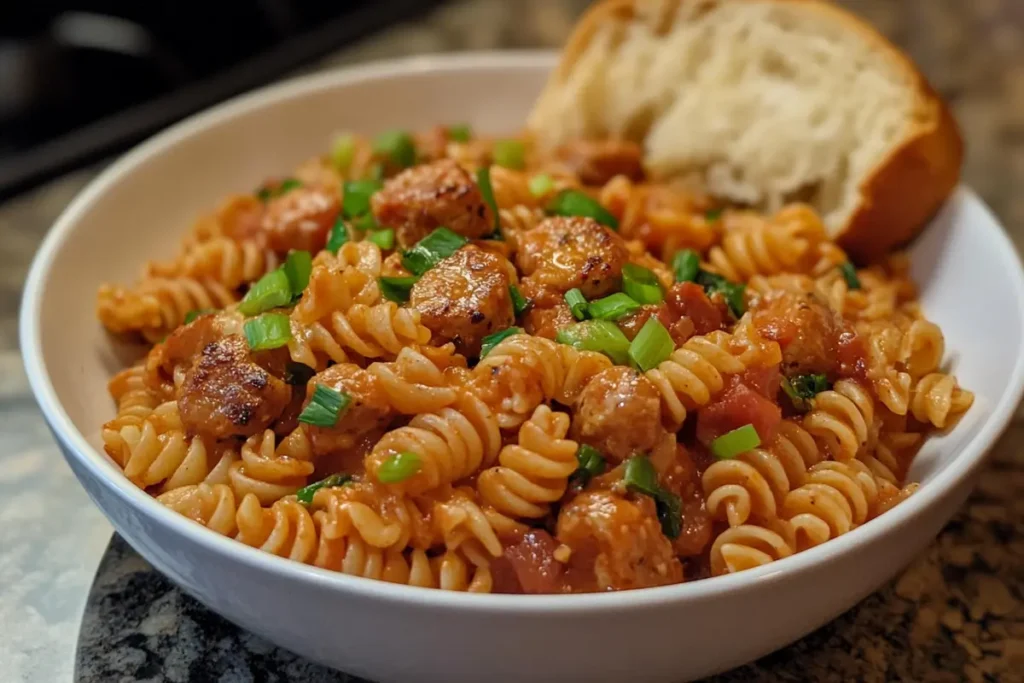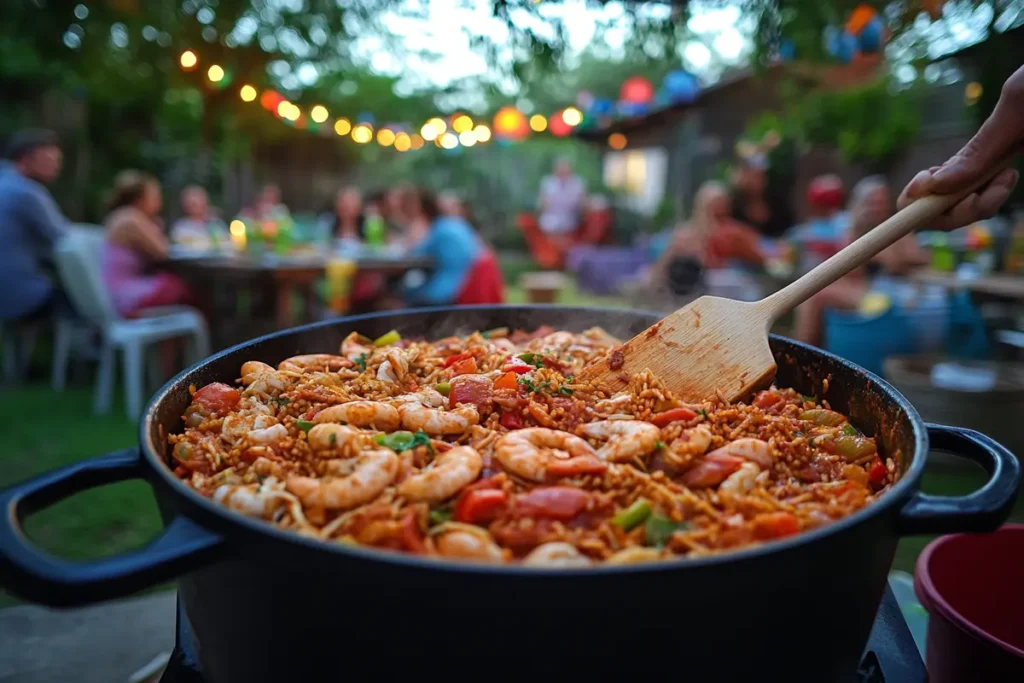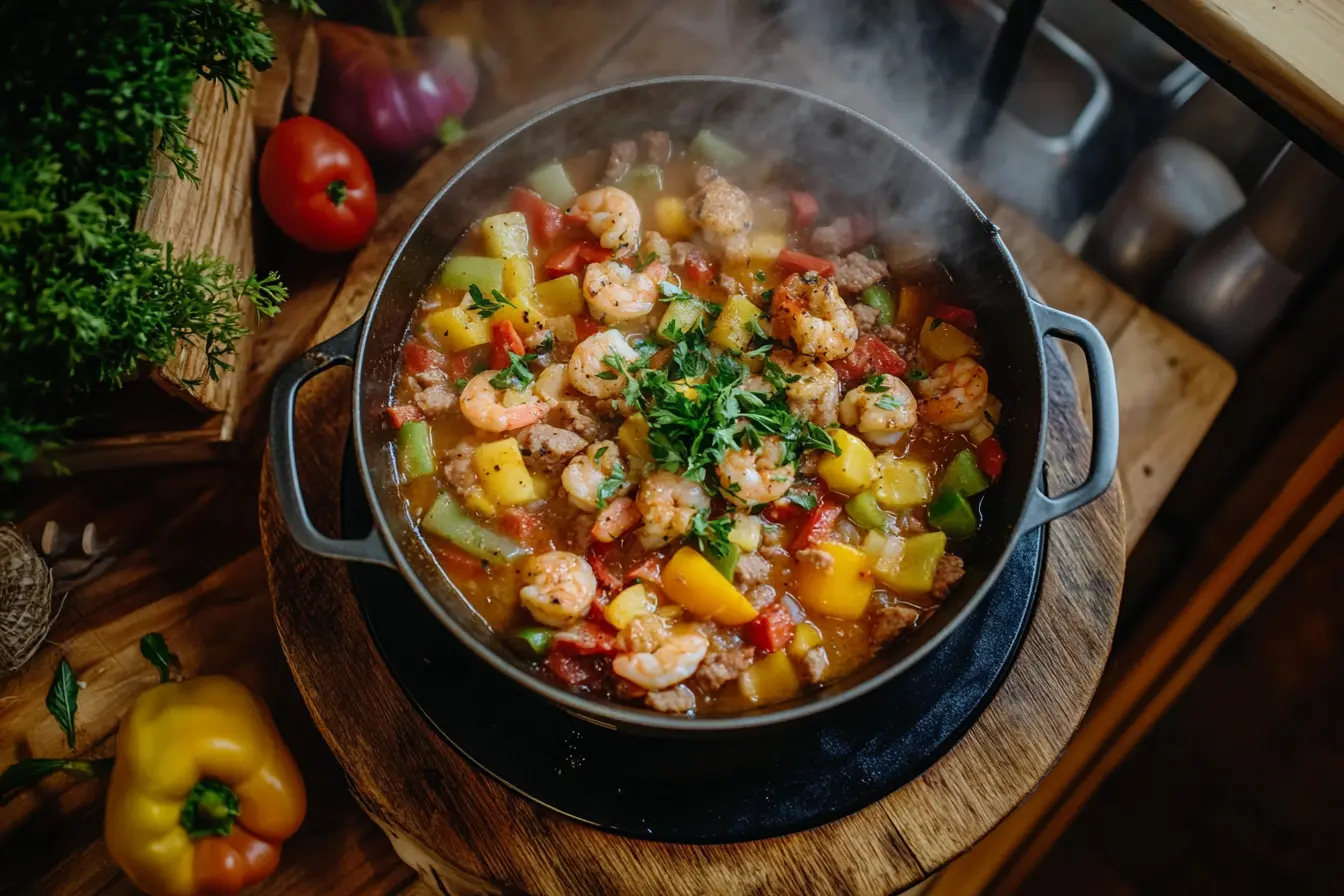The History and Evolution of Pastalaya
Introduction
If you’ve ever enjoyed a filling dish that feels like a perfect mix of tradition and creativity, you’ve likely tasted pastalaya. But what is the history of pastalaya? This tasty dish brings together the bold, smoky flavors of Cajun cooking with the cozy texture of pasta, making it a meal that’s both unique and comforting. In this article, we’ll uncover the origins of pastalaya, look at what makes it special, explore how it has changed over time, and compare it to its classic cousin, jambalaya. By the end, you’ll understand the story behind this beloved dish and its role in Southern food traditions.
What Is the History of Pastalaya? Exploring Its Roots
The Origins of Pastalaya in Cajun and Creole Cuisine
The story of pastalaya starts in Louisiana, where Cajun and Creole cooking thrive. These two rich food traditions, shaped by French, Spanish, African, and Caribbean roots, are known for their bold, tasty dishes. A key part of Cajun cooking is jambalaya, a dish full of smoky meats, veggies, and rice.
But how did pasta become part of the picture? Italian immigrants, who came to Louisiana in the late 1800s and early 1900s, brought their love for pasta with them. Over time, pasta became a common ingredient in local cooking. Eventually, pasta and jambalaya came together, creating the delicious fusion dish we now call pastalaya.
How Italian Influence Shaped the History of Pastalaya
Jambalaya, the dish that came before pastalaya, has a rich history. It likely started in Louisiana as a version of paella and quickly became a key part of Cajun and Creole diets. Made with rice, jambalaya was an affordable, one-pot meal that could feed large groups. Over time, families added their own twists by using different ingredients.
So, why swap rice for pasta? One big reason is convenience. Pasta cooks faster than rice and is just as versatile, making it perfect for busy cooks. Plus, pasta has a unique texture that soaks up Cajun spices wonderfully, giving the dish a new flavor. This blend of Italian and Cajun cooking created a fresh, exciting dish while still keeping its traditional roots.
Culinary Highlights: What Makes Pastalaya Unique?

Traditional Ingredients in Pastalaya’s History
When discussing pastalaya, the first thing that stands out is its ingredients. At its heart, pastalaya combines the rich, savory meats often found in Cajun cooking—such as smoked sausage, chicken, and shrimp—with the hearty texture of pasta. Unlike its predecessor jambalaya, which traditionally uses rice, pastalaya utilizes spaghetti or fettuccine to carry the flavors.
Preparation is a one-pot affair, with meats cooked first to create a flavorful base. The Cajun “holy trinity” of vegetables—onions, bell peppers, and celery—adds depth to the dish, while garlic and Cajun spices bring the signature heat and smokiness. The pasta is simmered directly in the broth and seasonings, soaking up every ounce of flavor, creating a dish that feels both familiar and unique.
The Flavor Profile That Defines Cajun Pastalaya
The flavor of pastalaya is bold and layered, showing off its Cajun roots. It has a smoky base, balanced by spicy heat and a touch of sweetness from caramelized vegetables. Traditional recipes rely on classic Cajun seasonings, but modern versions have popped up in different areas.
In some parts of Louisiana, cooks use cream-based sauces to make the dish richer. Others add tomatoes for a tangy, Creole-inspired twist. Some recipes even go beyond the usual Cajun spices, using ingredients like andouille sausage, wild game, or seafood to create unique regional flavors.
If you’re curious to explore more Southern-inspired recipes, check out this guide to Cajun comfort food classics.
The Difference Between Jambalaya and Pastalaya
First Documented Recipes and Mentions
The question What is the history of pastalaya? uncovers a relatively modern tale. Unlike jambalaya, which dates back centuries, pastalaya made its culinary debut in the late 20th century. It began appearing in Louisiana homes and community gatherings as cooks sought faster, more accessible alternatives to rice.
Cookbooks and recipe exchanges in the 1980s and 1990s started documenting the dish, highlighting its growing popularity. The convenience of pasta, coupled with its ability to absorb robust flavors, made pastalaya a favorite for family dinners and casual potlucks.
The Role of Pastalaya in Cajun Gatherings
Pastalaya quickly found a home at Cajun gatherings, from festivals to tailgating events. Its one-pot nature made it ideal for feeding large crowds, a hallmark of Southern hospitality. Today, it’s not uncommon to see huge pots of pastalaya simmering at festivals like the famous Jambalaya Festival in Gonzales, Louisiana.
The dish also plays a starring role in family traditions, served during holidays and celebrations. Its adaptability ensures it can be customized to suit any occasion, reflecting the creativity and resourcefulness of Cajun cooks.
Jambalaya vs. Pastalaya: Key Differences Explained
How Pastalaya’s Use of Pasta Changed Its History
At first glance, pastalaya and jambalaya may seem like twins, but subtle differences set them apart. Both dishes boast bold flavors and feature staples of Cajun cooking, such as smoked sausage, chicken, and shrimp. They also rely on the “holy trinity” of vegetables—onion, bell pepper, and celery—and a rich seasoning blend to deliver that unmistakable kick.
The primary difference lies in the base ingredient. While jambalaya uses rice to absorb the dish’s robust flavors, pastalaya swaps it for pasta, which soaks up seasonings differently and offers a distinct texture. Another difference is cooking time. Pasta cooks faster than rice, making pastalaya a more practical choice for quick meals or last-minute gatherings.
Why Pastalaya Has Become a Modern Cajun Favorite
Both pastalaya and jambalaya are culinary treasures in Cajun culture, yet they serve different roles. Jambalaya carries the weight of history, with roots stretching back to Spanish paella and French provincial cooking. It is considered a classic, reserved for traditional celebrations and larger community events.
Pastalaya, on the other hand, reflects a more modern evolution of Cajun cuisine. It emerged as a convenient twist on jambalaya while keeping the essence of Cajun flavors intact. This adaptability has helped it gain popularity not just in Louisiana but in kitchens around the world. If you’re curious about more quick Cajun-inspired recipes, explore this guide to versatile dishes.
Pastalaya in Modern Cuisine
Pastalaya in Restaurants and Homes
Today, pastalaya is a popular choice on menus at Cajun-inspired restaurants and a go-to meal for home cooks. Its flexibility allows chefs to get creative with ingredients while still honoring its traditional roots. For home cooks, it’s a simple one-pot meal that’s great for busy nights or special occasions. Whether adding different proteins or adjusting the spice level, pastalaya remains a favorite because it can be customized to suit anyone’s taste.
Fusion Dishes and Global Influence
The question What is the history of pastalaya? isn’t only about the past—it’s also about how the dish has changed to fit tastes around the world. Modern chefs have added fusion flavors, mixing Cajun spices with Asian, Italian, or Middle Eastern touches. For instance, some recipes use soba noodles instead of pasta, while others add harissa to the broth for a spicy kick. These creative twists keep pastalaya fresh and exciting in today’s global food scene.
For more ideas on creating hearty, flavorful meals, check out our guide to creamy comfort dishes.
FAQs About What is the history of pastalaya?
What Is the Difference Between Jambalaya and Pastalaya?
Jambalaya and pastalaya come from Cajun roots, but they aren’t the same. Jambalaya uses rice as its base, making it a hearty dish where rice soaks up all the flavors. Pastalaya, on the other hand, replaces rice with pasta. Pasta cooks faster and absorbs Cajun spices differently, giving the dish a unique taste and texture. Both dishes include similar ingredients like sausage, chicken, and shrimp, but their cooking styles and textures set them apart. So, when asking What is the history of pastalaya?, it’s clear that it’s a modern twist on a classic Cajun favorite.
When Was Pastalaya First Created?
Pastalaya first appeared in the late 20th century, making it a fairly new part of Cajun cuisine. It became popular as a quicker and easier version of jambalaya, great for busy cooks and feeding large groups. Its earliest mentions were in Louisiana community cookbooks and shared recipes, securing its spot in Cajun food traditions.
What Are the Traditional Ingredients in Pastalaya?
The ingredients in pastalaya are similar to those in jambalaya but adjusted for pasta. Common ingredients include smoked sausage, chicken, or shrimp, along with the Cajun “holy trinity” of onion, bell pepper, and celery. A mix of Cajun spices adds flavor, and instead of rice, pasta—usually spaghetti or linguine—is used. The pasta cooks in a rich broth, soaking up all the delicious seasonings..
Is Pastalaya Always Spicy?
Not necessarily! While Cajun dishes are known for their heat, the spice level in pastalaya can be adjusted. Many recipes allow you to control the seasoning, making it as mild or fiery as you like. It’s a dish that caters to diverse taste preferences while maintaining its signature Cajun flair.
Pastalaya Recipes: A Blend of Tradition and Innovation
Classic Pastalaya Recipe for Home Cooks
A traditional pastalaya recipe showcases the best of Cajun cooking. Begin by browning sausage and chicken in a large pot, allowing the meat to render its flavors. Add the holy trinity of vegetables—onion, celery, and bell peppers—along with garlic and Cajun spices. Once fragrant, pour in chicken broth and pasta, letting the noodles simmer until tender and coated in the flavorful sauce. This dish is a crowd-pleaser, perfect for potlucks and family meals.
Creative Twists on the Original Dish
In recent years, pastalaya has inspired countless variations. Seafood lovers might opt for shrimp or crawfish, while vegetarians can substitute meats with mushrooms or plant-based sausage. Some recipes incorporate cream for a rich, indulgent twist, while others use whole-grain or gluten-free pasta for a healthier option. These adaptations prove that pastalaya’s versatility knows no bounds, making it a favorite in kitchens worldwide.
For more creative takes on Southern-inspired dishes, explore this guide to versatile dinner ideas.
What is the History of Pastalaya in Louisiana Food Culture?
Pastalaya’s Role in Community and Celebration

Pastalaya is more than just a dish—it’s a symbol of togetherness. In Louisiana, food plays a key role in celebrations, and pastalaya is often the highlight of events like festivals, church dinners, and tailgates. Its one-pot cooking method makes it ideal for feeding large groups, strengthening its role as a meal that brings people together.
When asking What is the history of pastalaya?, it’s clear that the dish reflects the creativity and resilience of Cajun culture. By blending local flavors with Italian influences, pastalaya shows how a community can embrace new ideas while staying true to its traditions.
Global Variations Inspired by Pastalaya’s Rich History
Although it comes from Cajun and Creole roots, pastalaya has fans around the world. People everywhere love its bold taste and flexibility. Its influence has even led to fusion dishes, with chefs adding ingredients like Asian spices or Mediterranean vegetables. These creative variations show how food can connect cultures while keeping pastalaya’s original charm alive.
Recipes Inspired by the History of Pastalaya
A Classic Recipe That Honors Pastalaya’s Cajun Roots
As people look for healthier and more varied diets, pastalaya is changing. Many cooks now use gluten-free pasta, low-sodium broth, and plant-based proteins to fit modern tastes. These updates make pastalaya a dish that stays popular while meeting the needs of today’s health-conscious eaters.
The question What is the history of pastalaya? also points to its exciting future. This dish continues to inspire creative twists in kitchens and restaurants, keeping it a favorite in the world of comfort food.
Creative Twists That Show Pastalaya’s Versatility
Even as pastalaya evolves, efforts to protect its Cajun heritage continue. Community cookbooks, food festivals, and online recipe forums help keep traditional recipes alive. These efforts ensure that the heart of pastalaya—its bold flavors, community spirit, and cultural richness—stays central to Cajun cuisine.
Nutritional Content of Pastalaya (Per 100g)
Here is the estimated nutritional breakdown of a traditional pastalaya recipe per 100g serving:
| Nutrient | Amount | % Daily Value* |
|---|---|---|
| Calories | 165 kcal | 8% |
| Protein | 8 g | 16% |
| Fat | 6 g | 8% |
| Saturated Fat | 2 g | 10% |
| Cholesterol | 30 mg | 10% |
| Carbohydrates | 18 g | 6% |
| Fiber | 2 g | 8% |
| Sugar | 3 g | — |
| Sodium | 580 mg | 25% |
| Vitamin A | 400 IU | 8% |
| Vitamin C | 10 mg | 12% |
| Iron | 1.2 mg | 7% |
Notes:
- The nutritional values are approximate and depend on the specific ingredients and recipe used.
- Percent Daily Values are based on a 2,000-calorie diet. Your daily values may be higher or lower depending on your calorie needs.
This addition ensures the nutritional content is clear and user-friendly for readers. Let me know if you’d like further customizations!

